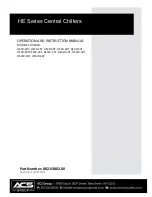
JOHNSON CONTROLS
166
FORM 155.32-ICOM1.EN.GB
ISSUE DATE: 10/13/2017
SECTION 8 – TROUBLESHOOTING
TABLE 42 -
TROUBLESHOOTING THE HIGH
TEMPERATURE GENERATOR
ITEM
CAUSE
COUNTERMEASURE
1
Cooling water is insufficient
or suspended.
• See if the cooling water supply rate conforms to the specification. (Check the flow
meter, discharge pressure of the cooling water pump, current, etc.)
• If the flow rate is insufficient, check the opening ratio of the flow controller valve
and check the strainer for clogging.
2
Cooling water temperature
at inlet is high.
Check the capacity of the cooling tower.
3
Non-condensable gas stays
in the machine.
• Check the capacity of the vacuum pump.
• Check the purge unit.
• Purge air from the chiller-heater (See
• If partial load operation continues for a long period, non-condensable gas tends
to stay in the absorber. In this case, purge directly from the absorber. Use the
instructions shown in
4
Heat exchange tube is dirty
(chilled/hot water, cooling
water).
Contact your local Johnson Controls Service Office.
5
Solution is crystallized.
6
Corrosion inhibitor is worn.
7
Air leaks in absorption
chiller-heater.
TABLE 43 -
REFRIGERANT OVERCOOLING RELAY
ITEM
CAUSE
COUNTERMEASURE
1
Chilled/hot water flow rate
lowers or changes sharply.
• See if the chilled/hot water flow rate changes sharply (particularly in the case
of variable flow rate specification).
• If it changes sharply, apply a limit of the change rate to the
chilled/hot
flow
control or take another measure.
2
Cooling water temperature
at inlet changes sharply.
• See if the cooling water temperature at inlet changes sharply (by checking
start and stop of the fan).
• If the chiller-heater refrigerant temperature is low, the chiller-heater stops
immediately but does not perform the diluting operation. If left as it is, the
solution may be crystallized in 4-5 hours. To prevent this, dilute the solution
according to the information shown in
Manual Refrigerant Blow Down and
.
3
Load lowers sharply.
See if the load changes sharply.
4
Refrigerant is dirty
(contains solution).
See if the refrigerant refining operation has been performed periodically. For
the refrigerant refining method, see
Refrigerant Refining Method on page
5
Heat exchange tube is
dirty (Chilled/hot water).
Contact your local Johnson Controls Service Office.
6
Temperature controller or
safety switch is broken.











































